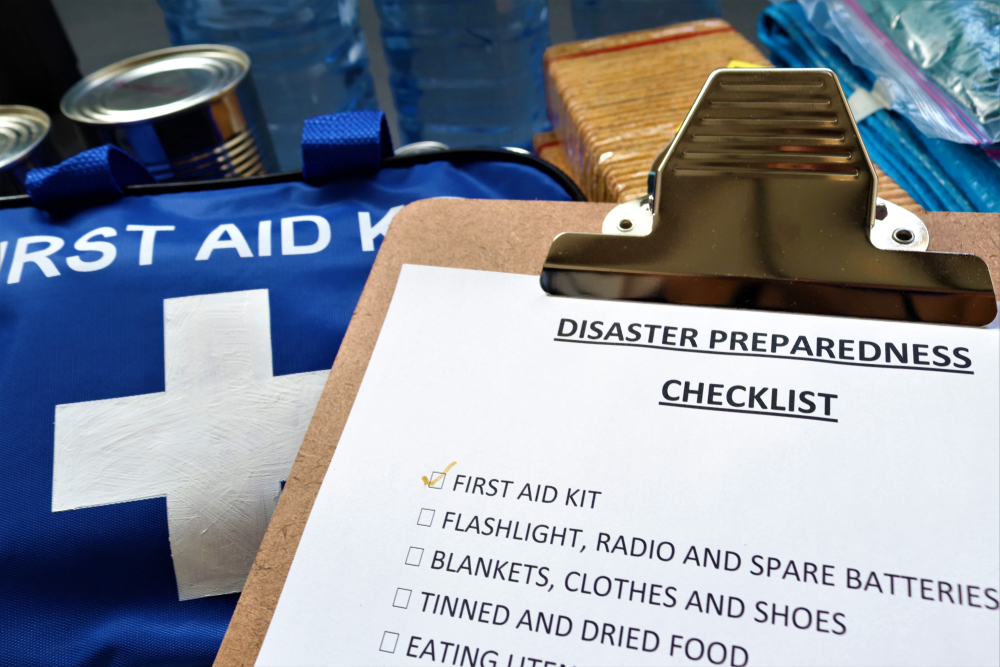
by siteadmin | Sep 13, 2019 | Emergency Preparations, Roof Damage, Severe Weather
Hurricane season isn’t over until the end of November. As the National Weather Service tracks storms and keeps everyone updated, make sure that you and your family are ready to wait out any severe weather. If you decide not to evacuate or can’t evacuate, these emergency supplies may be all you have to go on for a while.
While you should always maintain a kit of emergency supplies, it’s particularly important to double-check that kit this time of year and replace items as necessary. Don’t let yourself get caught by surprise with an expired kit. Use this checklist to make sure you have everything you need and a plan for staying safe this hurricane season.
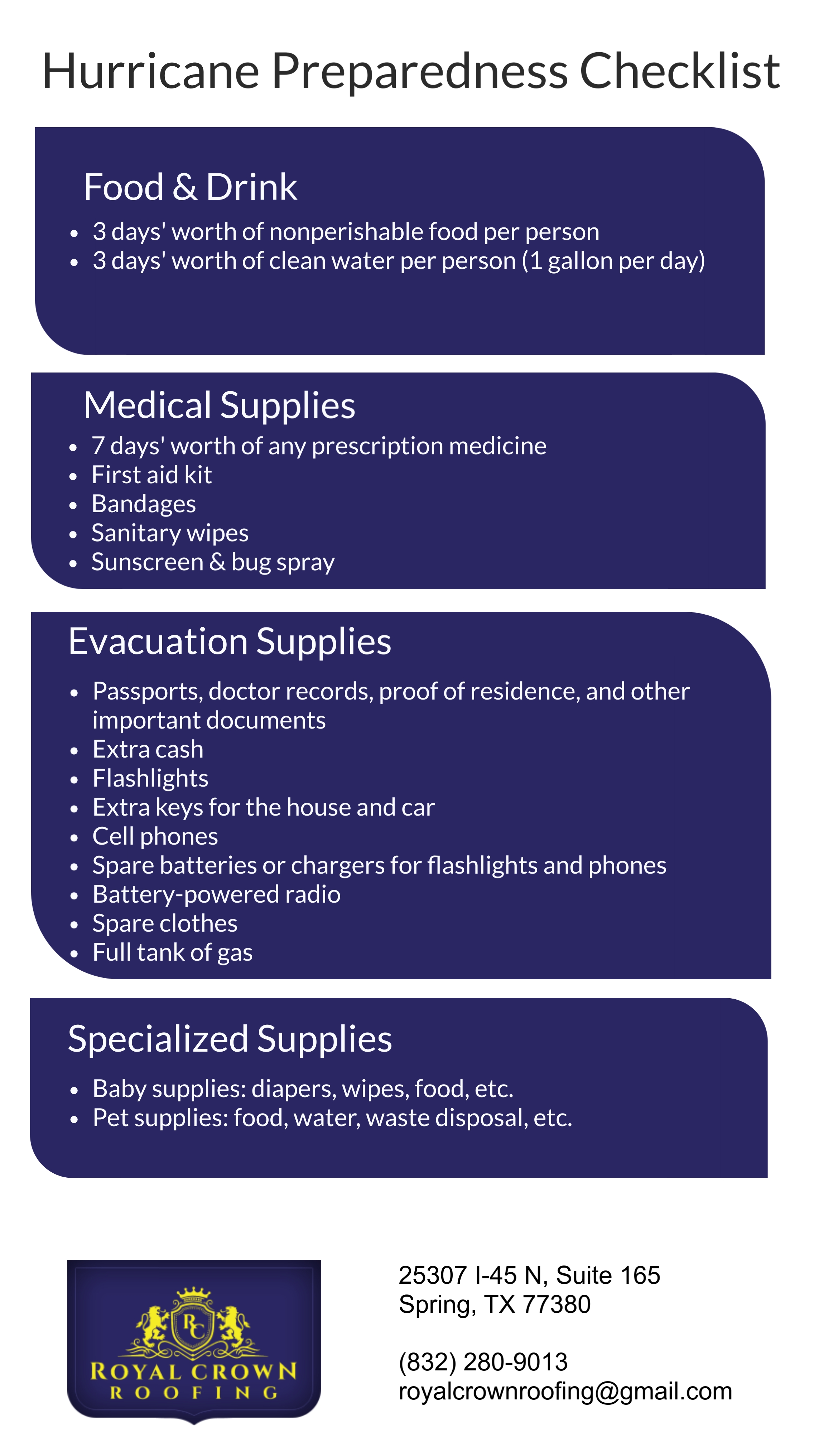
Food and Drink
Your disaster kit should contain a three-day supply of nonperishable food for each person in your home. Make sure it’s easy to open and prepare as well–for instance, opt for pull-tab tops on canned foods so you don’t have to worry about a can opener. Along with the food, make sure each family member has a three-day supply of clean water with at least one gallon per person per day set aside. Don’t substitute the water for other drinks like fruit juice or soda. While these drinks may taste better sometimes and last a while, because of their less beneficial nutritional content and the potential to increase thirst through high sugar content, they should be saved as a last resort.
Non-Edible Essentials
Of course, there are plenty of non-edible supplies you should include in your emergency kit. These include:
Medical Supplies
- 7-day supply of any prescription medicine your family needs
- Bandages
- Sanitary wipes
- First aid kit
- Sunscreen and bug spray
Evacuation Supplies
- Extra cash
- Copies of personal records: passports, proof of address, medical papers, etc.
- Family members’ contact info
- A full tank of gas
- Flashlights
- Hand-crank or battery-powered radio to monitor the weather
- Extra batteries
- Extra sets of keys for your house and car
- Cell phones and extra chargers and/or battery packs
- Spare clothes
Specialized Supplies
- Baby supplies: diapers, wipes, formula, etc.
- Pet supplies: food, carrier, leash, etc.
Pro Tip: Take before and after photos of your house to document any damage that may occur. Your insurance will appreciate it.
Before the Storm Hits
Keep your gas tank full and go down the checklist to see what supplies you may need. Keep an eye on the weather in the meantime. Prepare your home for severe weather by covering the windows, moving valuables inside, and any other steps you deem necessary. Most importantly, make sure your family knows the evacuation plan if it comes to that. Protect what’s really valuable.
Be Ready for Anything
Even the most advanced weather equipment is occasionally wrong. Sometimes, a hurricane projected to die at sea causes severe damage on land. We can never be completely sure what the weather might bring. The best we can do is make sure we’re ready to weather the storm.
Join the conversation for more ideas for your hurricane preparedness checklist.

by siteadmin | Sep 6, 2019 | Insurance Claims, Roof Insurance, Severe Weather
Roof repairs, while necessary to your comfort and your home’s long-term stability, can become expensive fairly quickly. Insurance can certainly help, but are you sure your policy covers everything you’ll need? Sometimes the fine print hides crucial exclusions or stringent rules that make filing a claim difficult.
Fortunately, there are several steps you can take to cooperate with your insurance provider and get repairs covered during an emergency event. Even if they can’t or won’t cover the entire job, following their preferred procedure will ensure you get a good amount of your money back. Let’s take a look at what to do to begin filing an insurance claim for roof damages.
Read Your Policy in Detail
Before you actually buy an insurance policy, read it in detail and make sure you know exactly what’s covered and what’s not. But by now, you’ve probably already had this policy for a while and want to take advantage of it. It still pays to read your policy carefully for any conditions or stipulations you may not have known about. For instance, several policies depend on the age of your roof. While some may cover up to 20 years, some policies expire after 10 years. You’re better off just replacing the entire damaged roof in a case like that.
Document Everything
As soon as it’s safe to do so, take a look at your roof’s interior and exterior. Take pictures of any sign of damage, even if it seems minor, for your insurance company to investigate. Label each picture with the date, time, and a brief explanation of what you noticed that concerned you.
Pro Tip: While you can certainly perform a cursory inspection of the damage, your insurance company is likely to take an expert’s opinion more seriously. Have a local roofing contractor inspect the damages and send your provider a detailed report.
Call Your Insurance Agent
Now that you have the relevant information from your policy and the documentation of damages, it’s time to contact your insurance company and begin the claim process. Continue to document any and all information they give you as you work through the problem. Your roofing company should be involved in this process as well to provide their estimate of repair costs and help advocate for you during the claim.
Insurance for Your Woodlands Roof
Don’t wait for your home or roof to suffer storm damage before pursuing quality insurance coverage. Even better, if you already have good insurance, take the time to study your coverage in detail and speak with an agent about any potential concerns. Waiting till an emergency situation to start learning how to file a claim for roof damage is perhaps one of the worst things a homeowner can do.
Join the conversation to learn more about filing a roof claim and protecting your home.
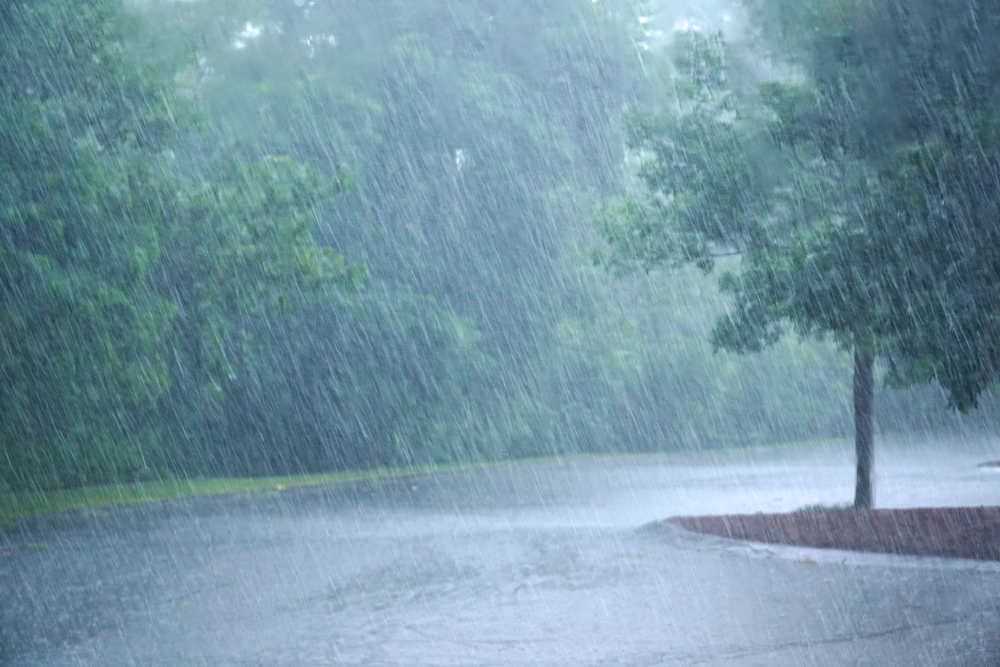
by siteadmin | Aug 30, 2019 | Emergency Preparations, Severe Weather
As summer draws to a close, plenty of homeowners are looking forward to not dealing with severe summer thunderstorms as frequently. However, Houston isn’t completely out of the woods yet. Even if heavy rains later in the year don’t quite measure up to a summer downpour, you may still find yourself dealing with severe weather a little longer.
Preparing Your Home
Aside from the basics of gathering emergency supplies for yourself and your family, make sure to get your home ready for the abuse a severe thunderstorm is sure to dish out. Even if you’re confident your home can take it, it never hurts to be prepared. Use this checklist to inspect your house and protect vulnerable spots:
- Check your roof, outside and inside
- Clear your gutters
- Protect valuable outdoor items
- Check your windows and doors
1) Check Your Roof, Outside and Inside
If you don’t have time to get a free expert inspection, take a few minutes to examine your roof yourself. Any signs of a leak on the inside or outside of your roof should be covered immediately with a tarp and repaired as soon as the rain stops. Don’t let your home or belongings be damaged even by the possibility of a leak.
2) Clear Your Gutters
Gutters notoriously fill with leaves, twigs, and other debris over time, making it difficult for them to effectively drain your roof. For a long-term solution, considering installing gutter guards to prevent clogging. If you don’t have gutter guards yet, quickly check to ensure the gutters are clear and clean them out before the storm hits.
Pro Tip: If rainwater can’t drain properly off your roof, it weighs down in puddles and can cause leaks or collapsing. That’s why it’s so important to keep your gutters clean.
3) Protect Valuable Outdoor Items
Most homeowners have a few belongings they keep outside, such as grills, bicycles, or outdoor furniture. However, even water-resistant items will sustain some damage in a severe downpour. Bring everything inside before the storm hits to keep your outdoor valuables safe.
4) Check Your Windows and Doors
Finally, remember that your roof isn’t the only part of your house that can leak. Make sure the seals around your windows and doors are still secure and doing their job. If you find a leak, cover it temporarily with a waterproof protector until you can repair it later.
Protecting Your Conroe Home
In areas prone to severe weather and heavy rain, houses are built to endure the storms. However, every house has its flaws, especially as time passes and the original construction loses some of its strength. The best thing you can do as you prepare for heavy rain is to take a few extra steps to protect your home from severe damage through periodic inspections and maintenance.
Connect with us to learn more about preparing your home for the last bit of severe summer weather.
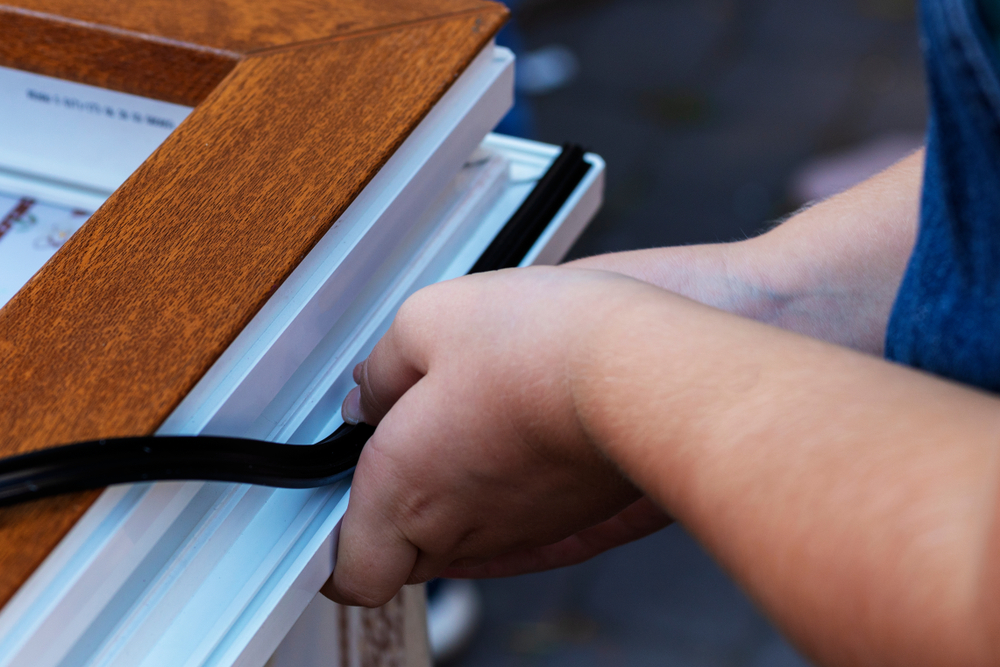
by siteadmin | Aug 23, 2019 | Home Renovation, Roofing Insulation, Roofing Materials
When you think about insulation for your home, you probably think of keeping the heat inside during cold weather. While this is certainly one application of insulation, a different type of material can actually help keep heat out. Believe it or not, using the right kind of insulation in the right places can actually repel heat and keep your home cool in the summer.
If you’re looking for the best insulation to keep heat out, you can’t go wrong with the two most popular and effective choices: weather stripping and radiant barrier insulation. Properly used, both will seal your air conditioning inside and repel the heat outside. How can these help your house as the weather stays warm?
Weather Stripping
Some of the most common places for climate-controlled air to escape is around your windows and doors. A crooked window or door could be raising your energy bills significantly by providing a constant slow leak. Fortunately, this is an easy fix. Strategically placing weather stripping around the edges will block most leaks and allow your home’s climate to balance itself out again.
Pro Tip: Be skeptical of any window company that claims to be able to reduce your energy bills with replacement windows. These claims are borderline illegal, often incorrect, and have gotten several companies sued. Save your money and install weather stripping instead.
Radiant Barrier
Radiant barrier insulation does more than just keep cool air inside. This reinforced layer of aluminum lines the inside of your attic roof and reflects heat back outside. Even this thin layer of insulation is surprisingly effective–a study shows that proper installation of a radiant barrier could save between 10-15% on energy costs. Just make sure your roof builder knows how to properly install insulation!
A Few Mistakes to Avoid
Of course, insulation material should be handled with care and isn’t effective in every place in the house. Keep these common errors in mind as you plan your insulation project:
- NEVER put insulation on or near active knob and tube wiring–that’s a great way to start a fire. Have the hazardous equipment professionally removed first.
- Avoid insulating spaces that won’t affect the transfer of heat much, such as exterior walls. You’ll just end up spending a lot of money for very little change.
- Don’t block any ventilation or HVAC ductwork with insulation–this will only make the problem worse.
Stay Cool!
Your air-conditioned home is your refuge against the high temperatures of any Houston day. By researching and installing the best insulation to keep heat out of your house, you’re sure to continue enjoying the comfort of a climate-controlled house for years to come.
Connect with us to learn more about preparing your roof and house for hot weather.
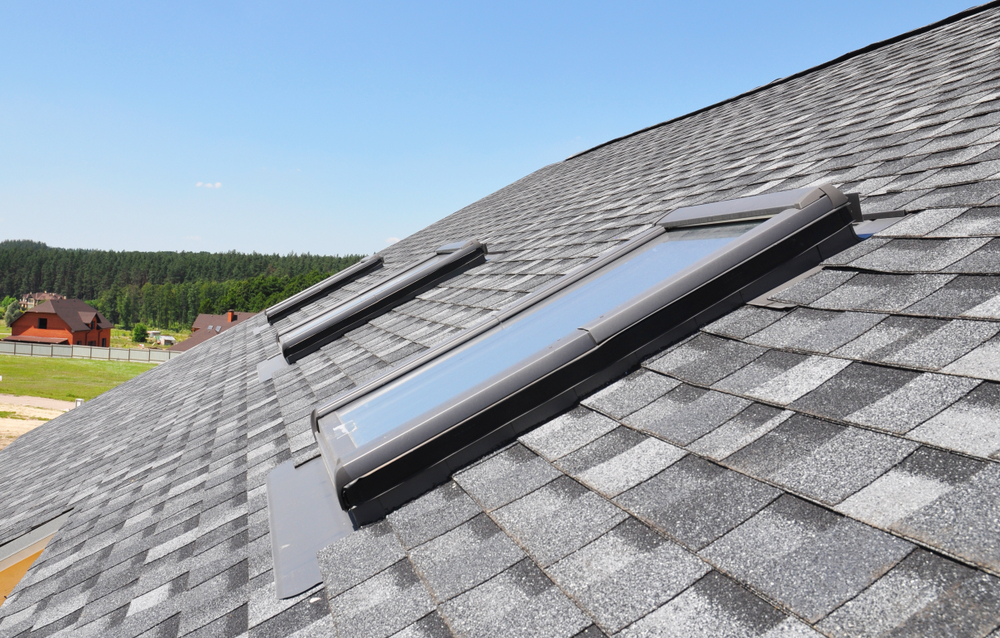
by siteadmin | Aug 16, 2019 | Home Renovation, Roofing Materials, Severe Weather
Are you thinking of upgrading or replacing your roof? What materials are you planning to use? Not all roofing materials are created equal, after all. Most homeowners generally try to find the most cost-effective, longest-lasting roof material they can.
Different types of roofing material are appropriate for different home locations, as well as previous damages done to the roof. While certain types of roofing materials last longer than others, it’s also important to remember that some types may not be appropriate for a particular setting. The best thing to do is to look at the different types of available materials and see which is the best fit for your home.
Shingles
High-quality asphalt shingles are still the most popular choice for the majority of homeowners. The slightly higher cost of these roofing materials are more than worth it–well-made shingles will last 20 years or more. Roofing shingles are also among the easiest roof materials to replace or patch following roof damages. These popular materials stand the test of time!
Pro Tip: Some homeowners opt for wood shingles and shakes. Similar to asphalt shingles, wood shingles have an expected lifespan of about 20 years but can last much longer in mild weather.
Tiles
Roofing tiles made of concrete, clay, or slate have a staggering life expectancy of 100 years! Even so, tiles are more of a challenge to install or maintain than shingles. For instance, the building materials are significantly heavier and more expensive, making a project with them more difficult. Additionally, poorly made shingles can crack or split during severe weather such as a hailstorm. While tiles are certainly an elegant and durable choice, it pays to double-check their quality and make sure your local weather won’t cause you problems later on.
Metal
Metal roofing generally lasts 40-60 years and is arguably the strongest of any conventional building material. However, certain types of damage (like a dent or rusty spot) require most of the roof to be replaced since the metal is likely all a solid piece. Additionally, between materials and installation costs, you’ll end up paying more overall for a metal roof. Talk to your roofing contractor to see if it’s in your best interest to opt for metal.
A Houston Roof that Will Last for Decades
A well-constructed roof of long-lasting roofing material will survive for decades in most cases. Depending on your home’s location, your current roof’s condition, and your own preferences, you can easily opt for an excellent roof to protect your home for years to come.
Connect with us to learn more about the best roofing material for your home.
Page 7 of 10« First«...56789...»Last » 








